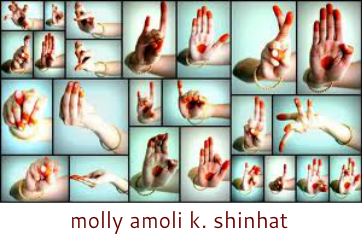Speculative Labels
Speculative Science : Jan Allen
Carleton University Art Gallery
Identified Artistic Objects. Museums and art galleries the world over are filled with them. My plan was to review Jan Allen's show. Called Speculative Science, it features several installations of varying proportions, predominantly made of wax, wood, wire, copper and steel. Something about them reminded me instantly of a performance I'd seen years ago—the great Québeçois dancer, Marie Chouinard's interpretation of Nijinsky's L'Après-midi d'un fauneat the Monument National in Montreal.
But, dear Reader, something dreadful came between me, my thoughts and the art—the labels.
Traditionally, labels embrace the practical no-nonsense approach identifying the artist, title, birthdate/ deathdate, the year the piece was made, and the media it was made in. But these labels go much further. Below the basic identification, the label continues with one or two interpretive paragraphs.
With no author identified nor any source, these paragraphs felt like didactic voice-of-God interpretations, fascinating though they were. The text addressed everything from the themes to interpretation and analysis.
I, personally, have never seen anything like this: text obviously promoting an interpretation on the identification label. Had the intriguing text been identified as the curator's, as being culled from the exhibition catalogue, I would have been sufficiently informed to choose not to read them at all.
To look at the work "cold" is my cardinal rule. That is, looking at the work itself, with no other support material, particularly no written material—unless it forms part of the work. All other perspectives including the artist's can be sought out later, either in person or in the catalogue.
According to Sandra Dyck, the curator and label writer, the motivation for the "informational labels" (her description) was, "to give people something to go on, ...[...] some tools for thought, some of the ideas that Jan is working with." She pointed out, " We try not to assume that the audience knows anything about Jan or about her work, or maybe even about contemporary art...."
Perhaps the "informational label" helps fill us in. I mean, what do we know? According to Dyck, the presentation has Allen's complete condonation. Wow, this is depressing.
As the audience, we're receptive to lightening, but we receive it through the curator—as a conductor, not a source. Strong creative work nourishes sacred communication between creator and audience —particularly when the message is not the one intended by the artist. It is precisely in that intimate limitless space of our imaginations that the mind can truly be stretched—the artist's and/or the viewers.
How could any of this happen if we are not free to look at art without a disembodied voice in the exhibition itself trying to lead us?
At the Carleton University Art Gallery, according to Ms. Dyck, the "informational labels" have garnered accolades. People appreciate the "hints". Perhaps I'm alone in still wanting to be challenged by art—maybe think for myself or, dare I say it, even feel.
Ironically the side order of McArt labels achieved precisely the opposite of the artist's apparent intention. What was it? Something about speculating and science? But that's just it! The presentation interfered with my freedom to speculate.
Published in The Ottawa Xpress
But, dear Reader, something dreadful came between me, my thoughts and the art—the labels.
Traditionally, labels embrace the practical no-nonsense approach identifying the artist, title, birthdate/ deathdate, the year the piece was made, and the media it was made in. But these labels go much further. Below the basic identification, the label continues with one or two interpretive paragraphs.
With no author identified nor any source, these paragraphs felt like didactic voice-of-God interpretations, fascinating though they were. The text addressed everything from the themes to interpretation and analysis.
I, personally, have never seen anything like this: text obviously promoting an interpretation on the identification label. Had the intriguing text been identified as the curator's, as being culled from the exhibition catalogue, I would have been sufficiently informed to choose not to read them at all.
To look at the work "cold" is my cardinal rule. That is, looking at the work itself, with no other support material, particularly no written material—unless it forms part of the work. All other perspectives including the artist's can be sought out later, either in person or in the catalogue.
According to Sandra Dyck, the curator and label writer, the motivation for the "informational labels" (her description) was, "to give people something to go on, ...[...] some tools for thought, some of the ideas that Jan is working with." She pointed out, " We try not to assume that the audience knows anything about Jan or about her work, or maybe even about contemporary art...."
Perhaps the "informational label" helps fill us in. I mean, what do we know? According to Dyck, the presentation has Allen's complete condonation. Wow, this is depressing.
As the audience, we're receptive to lightening, but we receive it through the curator—as a conductor, not a source. Strong creative work nourishes sacred communication between creator and audience —particularly when the message is not the one intended by the artist. It is precisely in that intimate limitless space of our imaginations that the mind can truly be stretched—the artist's and/or the viewers.
How could any of this happen if we are not free to look at art without a disembodied voice in the exhibition itself trying to lead us?
At the Carleton University Art Gallery, according to Ms. Dyck, the "informational labels" have garnered accolades. People appreciate the "hints". Perhaps I'm alone in still wanting to be challenged by art—maybe think for myself or, dare I say it, even feel.
Ironically the side order of McArt labels achieved precisely the opposite of the artist's apparent intention. What was it? Something about speculating and science? But that's just it! The presentation interfered with my freedom to speculate.
Published in The Ottawa Xpress

